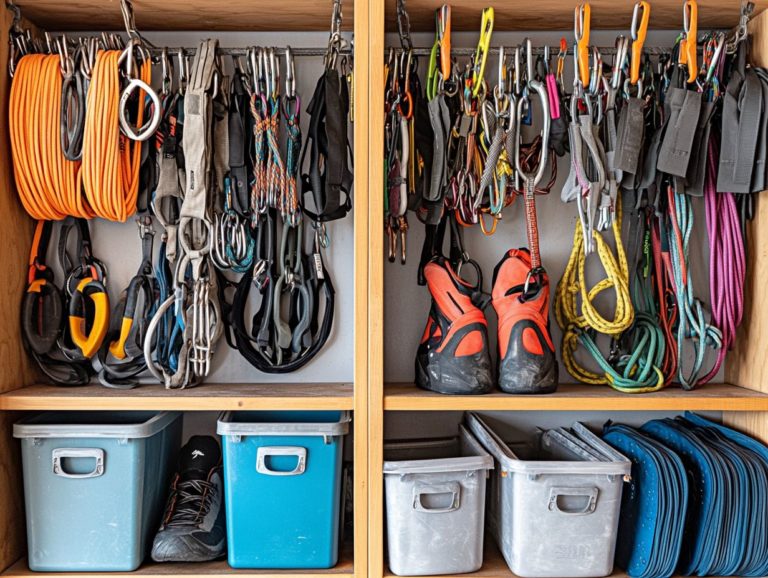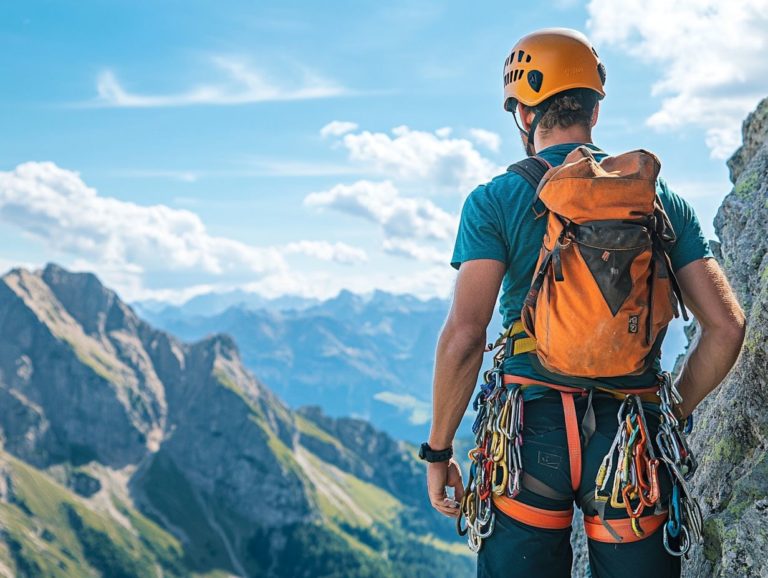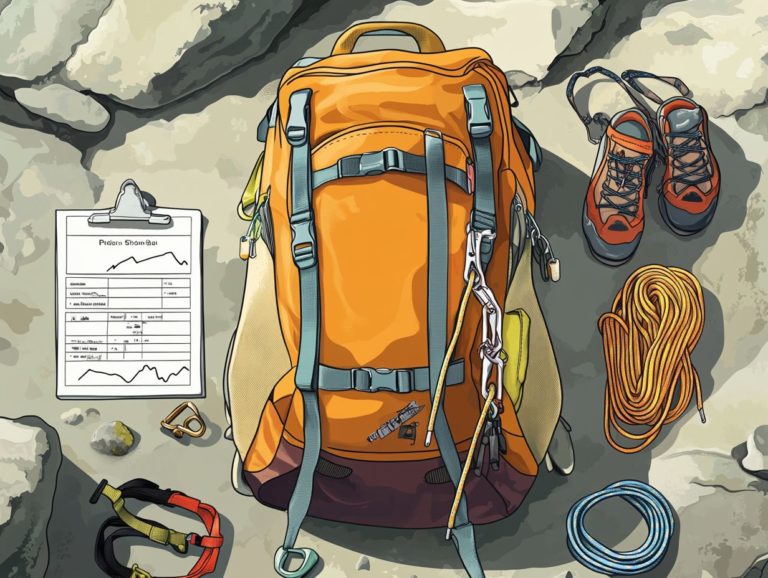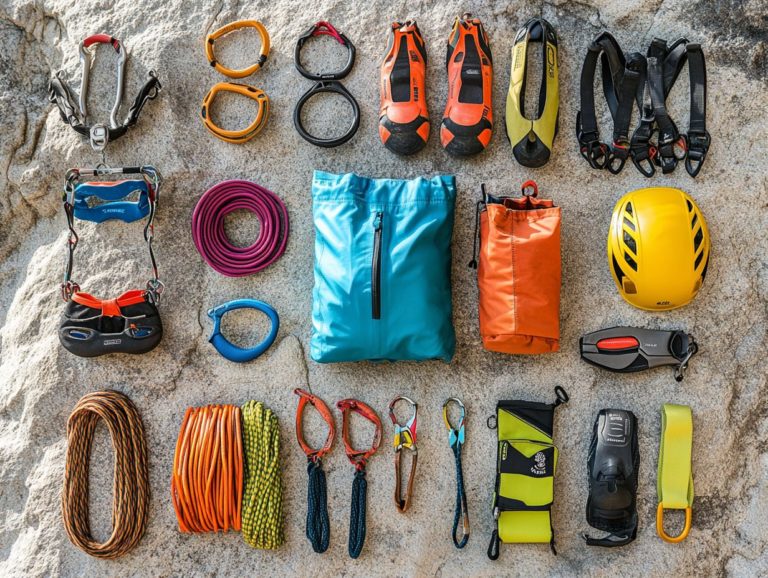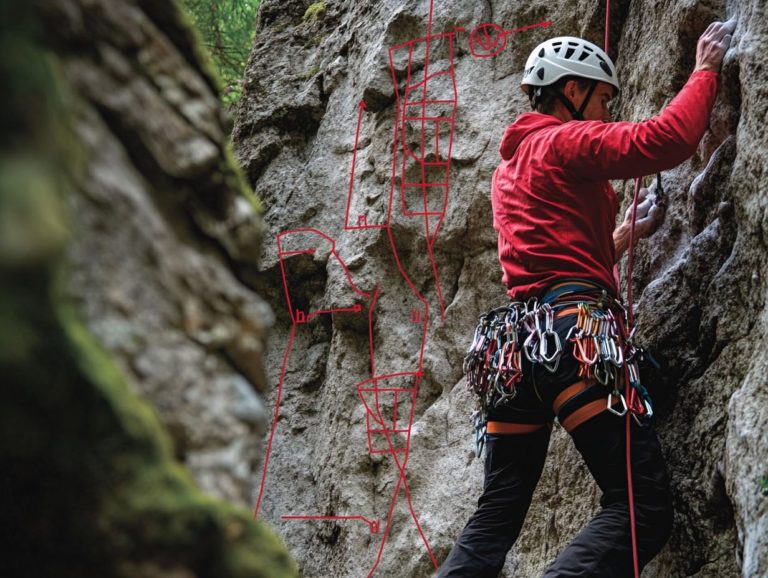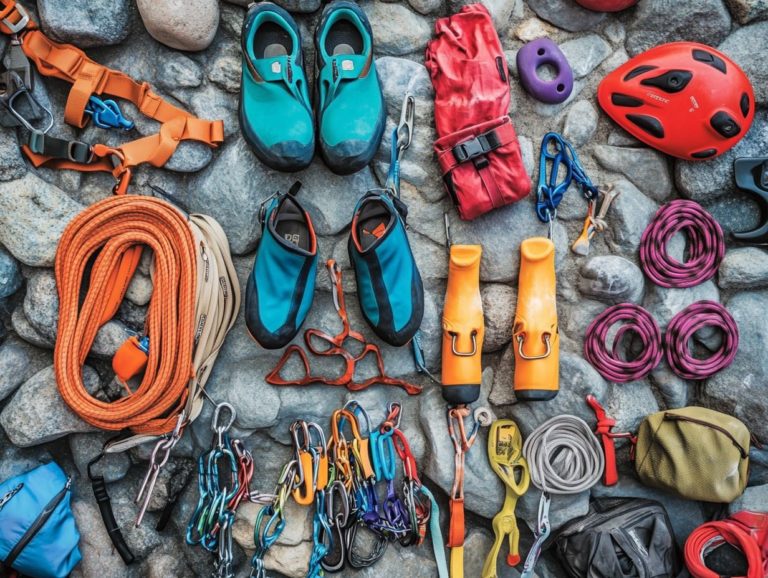The Essential Gear for Indoor Climbing
Indoor climbing presents an exhilarating opportunity for you to challenge yourself both physically and mentally. You can immerse yourself in a vibrant social atmosphere that mirrors the thrill of outdoor rock climbing.
Whether you re just starting out or have years of experience under your belt, grasping the fundamentals can significantly enhance your enjoyment and ensure your safety. This guide delves into the essential gear you ll need everything from climbing shoes to harnesses and provides valuable tips for selecting the right equipment.
You ll also discover crucial techniques, safety measures, and climbing etiquette that will boost your climbing adventures. Prepare to elevate your climbing game to new heights!
Contents
- Key Takeaways:
- The Basics of Indoor Climbing
- Essential Gear for Indoor Climbing
- Tips for Choosing and Using Gear
- Key Factors for Indoor Climbing
- Frequently Asked Questions
- What is considered essential gear for indoor climbing?
- Do I need to buy my own gear for indoor climbing?
- What type of climbing shoes are best for indoor climbing?
- Can I use a regular gym bag for my climbing gear?
- Is it necessary to use a chalk bag while climbing indoors?
- Do I need to bring my own rope for indoor climbing?
Key Takeaways:
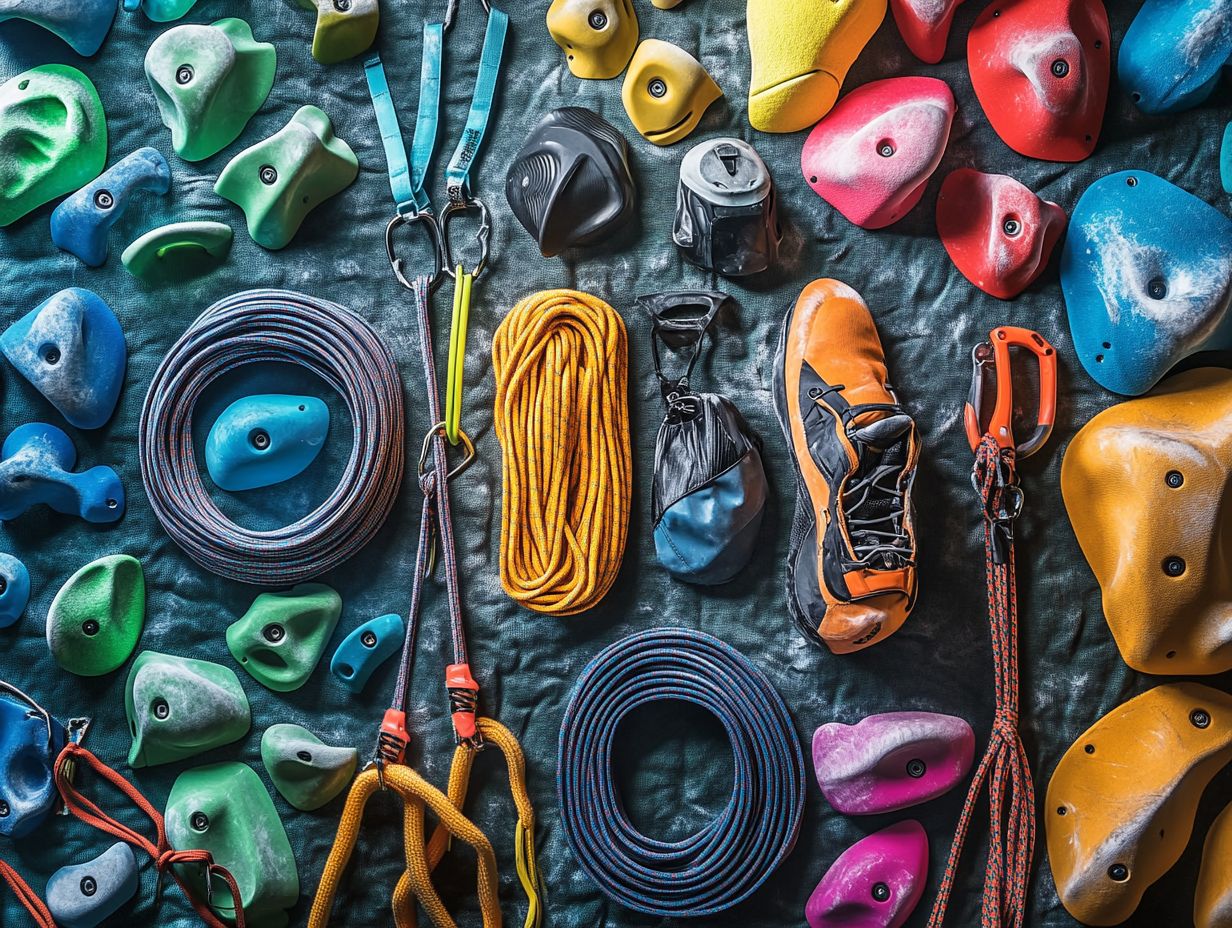
- Proper fitting and comfort are essential when choosing gear for indoor climbing. Improper gear can hinder performance and increase the risk of injury.
- Climbing shoes, a harness, and a chalk bag are the basic gear needed for indoor climbing. A rope and belay device, such as a belay carabiner, are also crucial for safety.
- Mastering climbing techniques, knowing safety measures, and embracing etiquette will boost your climbing adventures!
The Basics of Indoor Climbing
Indoor climbing is a fun version of rock climbing that invites you to immerse yourself in the sport within the controlled ambiance of climbing gyms. This engaging activity accommodates climbers of every skill level, offering a platform for both novices and seasoned professionals alike, including celebrated athletes such as Kai Lightner and Ben Hanna, to refine their craft across diverse walls and routes.
With essential climbing gear like chalk bags, climbing shoes, and harnesses at your disposal, you can savor the exhilarating experience of climbing while prioritizing safety and technique in a nurturing environment.
What is Indoor Climbing?
Indoor climbing offers you a unique way to experience rock climbing on artificial walls that are expertly crafted to simulate various outdoor climbing adventures.
These walls are constructed with precision, using a mix of plywood and textured holds that allow you to practice on surfaces mirroring the diverse terrains found in nature. Whether you prefer bouldering, top-rope (where the rope is anchored from above), or lead climbing, these facilities cater to all styles, giving you the chance to refine your skills in a safe and controlled environment.
You’ll find design elements like overhangs, ar tes, and even cracks, all designed to replicate the challenges encountered on real rock faces. Climbing gyms are not just training spaces; they are vibrant hubs for a community of climbers, providing opportunities to share knowledge, compete, and engage with the sport on a much deeper level.
Essential Gear for Indoor Climbing
Equipping yourself with the right gear is essential for a safe and enjoyable indoor climbing experience. It significantly influences both performance and safety.
Key climbing essentials include specialized gear like:
- Specialized shoes, like the Evolv Defy, designed to enhance your grip and mobility.
- A sturdy climbing harness is vital for ensuring your safety as you navigate various routes.
- A reliable belay device, such as the Petzl Grigri, is critical for managing the rope effectively when belaying a partner.
- Don’t forget a chalk bag, which keeps your hands dry to help you maintain a solid grip on those climbing holds.
Climbing Shoes
Climbing shoes are a vital component of your gear, meticulously designed to deliver optimal performance, grip, and support across a range of climbing surfaces.
These shoes are crafted from specialized materials that enhance durability while providing the necessary flexibility. Achieving a snug fit is essential; it allows you to maximize the effectiveness of each movement and truly connect with every nuance of the rock or wall.
Selecting the right size can profoundly impact your comfort and control too loose, and you risk slipping; too tight, and you could face discomfort that detracts from your performance.
Models like the Evolv Defy shine in their versatility, making them perfect not only for newcomers but also for seasoned climbers who seek a harmonious blend of comfort and functionality, ultimately elevating their climbing experience.
Harness and Chalk Bag
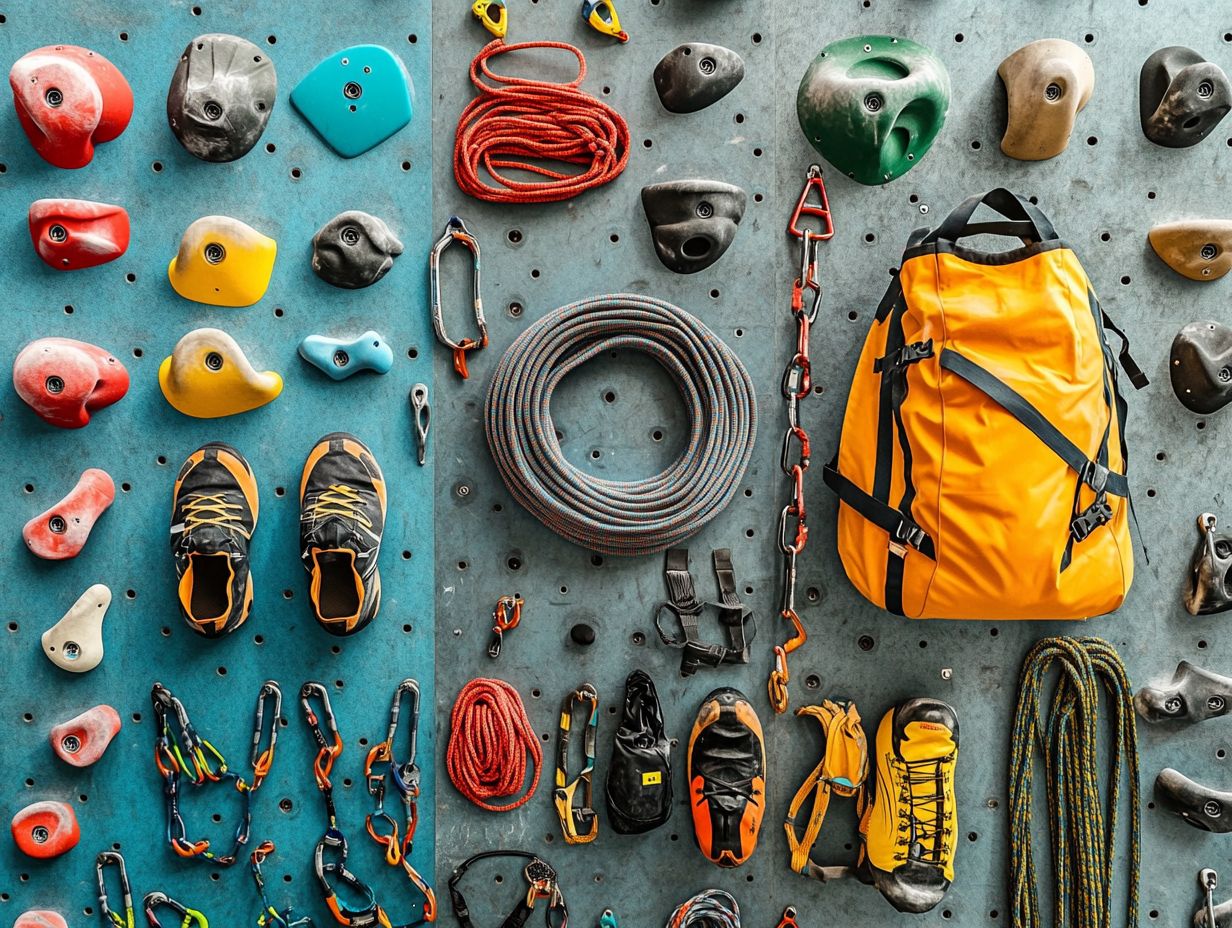
A climbing harness is important safety gear that allows you to secure yourself while ascending. A chalk bag is your trusty sidekick for keeping your hands dry for that all-important grip. This essential gear promotes safety by distributing the force of a fall across your body and ensures comfort with designs tailored to different climbing styles and body shapes.
You’re presented with a variety of harness types, ranging from straightforward figure-eight models perfect for beginners to advanced sport and mountaineering harnesses loaded with features like gear loops (which allow you to attach other gear) and padded leg straps for comfort. This diversity ensures you can find the perfect fit for your unique needs.
Equally crucial is the chalk bag, often underestimated, but it significantly enhances your climbing performance, especially when using high-quality chalk from Rhino Skin Solutions. The chalk bag offers a quick and easy way to access chalk from reputable brands like Chalk Cartel, which provides a range of sizes, styles, and functionalities designed specifically for both sport climbers and bouldering fans. To ensure you’re fully prepared, check out what gear is required for rock climbing. Gear up wisely to conquer new heights!
Climbing Rope
Climbing ropes are critical for ensuring your safety in both indoor and outdoor climbing, as they play a crucial role in securing you during ascents and descents.
It s essential for anyone involved in climbing activities to grasp the differences between dynamic and static ropes. Dynamic ropes are engineered to stretch under load, effectively absorbing impact during a fall, making them essential for lead climbing and multi-pitch routes. In contrast, static ropes don t stretch significantly, making them better suited for rappelling, rescue operations, and situations where minimal stretch is paramount.
Choosing the right rope not only bolsters your safety but also enhances effective belaying, ensuring you are securely anchored while navigating challenging terrains.
Belay Device
A belay device is essential for managing the climbing rope safely during belaying, ensuring you and your fellow climbers are securely attached and can be lowered or caught in case of a fall.
These devices act as a crucial link between you and the belayer, giving you control over the rope’s movement. Among the plethora of options available, the Petzl Grigri shines for its versatility and user-friendly design, making it a top choice for both novice and seasoned climbers alike.
When utilized properly, these devices significantly enhance safety in indoor climbing settings by facilitating smooth rope handling and precise tension adjustments. It s vital for you to understand how to use these tools correctly; improper use can lead to serious accidents.
Thus, being familiar with the specific features of popular models is essential for every climbing enthusiast.
Other Recommended Gear
Along with your essential climbing gear, several other items can elevate your indoor climbing experience and overall performance.
For instance, incorporating foam rollers into your routine can work wonders for muscle recovery, alleviating soreness and improving flexibility after those demanding climbs. Hand exercisers are invaluable for developing grip strength, giving you the confidence to tackle challenging routes. And let s not overlook chalk it s vital for keeping your hands dry, which is crucial for grip and safety.
Brands like Addaday are known for quality foam rollers, while specialized hand exercisers and chalk can truly enhance your climbing experience. To further improve your climbing adventures, consider exploring the top 10 must-have climbing gear accessories. By utilizing these supplementary tools, you not only boost your performance but also invest in your long-term well-being as a climber, regardless of your level.
Tips for Choosing and Using Gear
Selecting the right climbing gear is crucial for ensuring your comfort, safety, and performance. It’s essential for you to focus on both fit and quality, as these factors can significantly impact your climbing experience.
Fit and Comfort
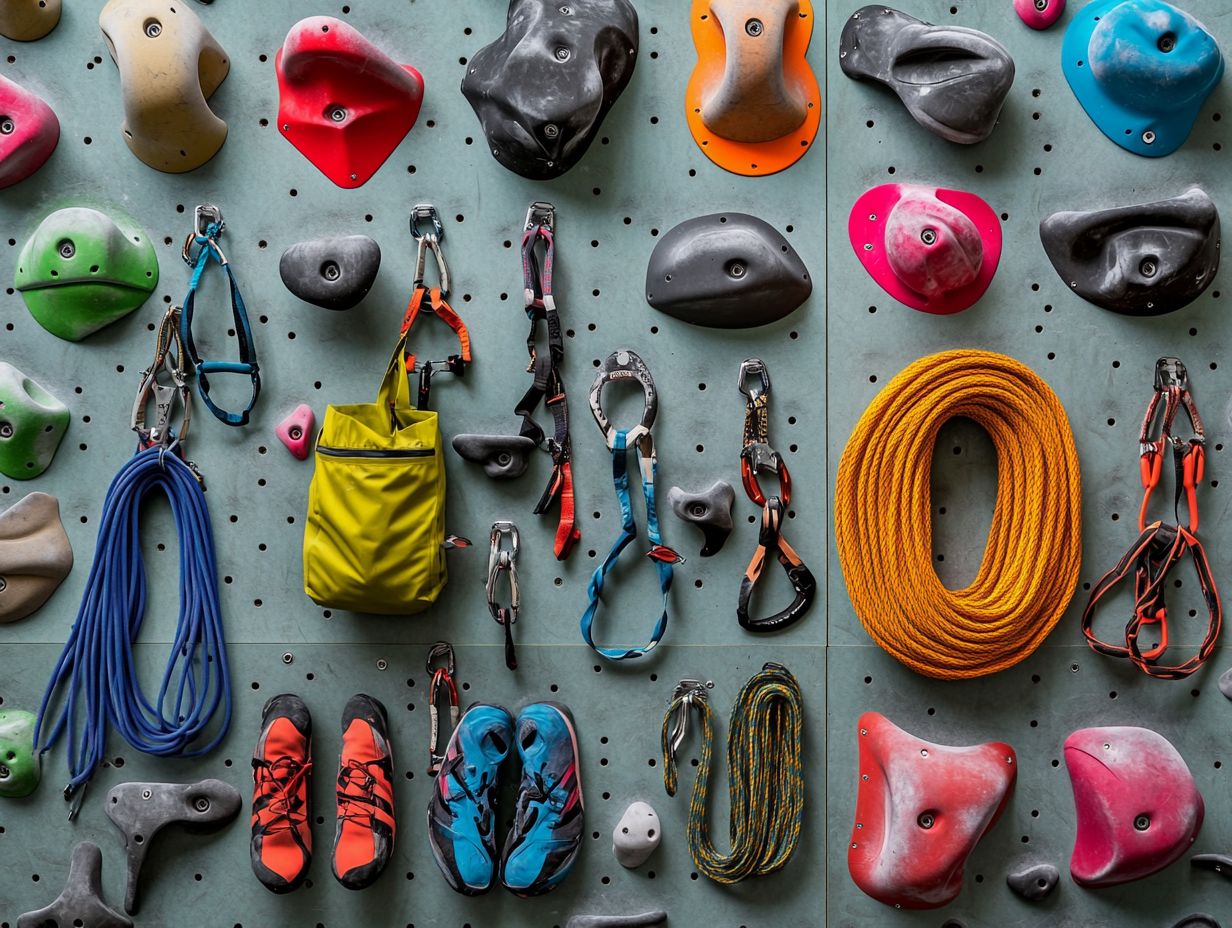
A proper fit is crucial when selecting your climbing shoes and harnesses. Ill-fitting gear can lead to discomfort and compromise your performance.
You must recognize that every climber’s foot shape and body type is unique. Individualized fitting should be a top priority. Trying on various sizes and models is key since each brand has its unique sizing and stretch characteristics, including popular brands like 8bPlus.
When testing climbing shoes, don t just focus on the snugness; also consider the freedom of movement in your toes. They shouldn t feel crammed in, but they should be held securely.
For harnesses, adjust the straps for a snug fit around your waist and legs. Pay attention to how it feels as you move. Comfort is paramount for a successful climbing experience, so invest time to find the gear that feels just right for you, whether it s climbing harnesses or shoes.
Proper Use and Maintenance
Proper use and maintenance of your climbing gear are essential for safety and improving your skills while climbing indoors.
Before tackling the walls, inspect your equipment thoroughly. Check your harness for frays, ensure your carabiners open and close smoothly, and inspect your ropes for signs of wear or damage.
These pre-climb checks can significantly reduce the risk of accidents. Routine maintenance practices are vital for preserving the integrity and functionality of your climbing gear. Clean your gear after each use, store it in a cool, dry place, and follow the manufacturer s recommendations to prolong its lifespan.
Key Factors for Indoor Climbing
Indoor climbing involves much more than just the physical demands of the sport; it immerses you in techniques, safety measures, and the etiquette that every climber should embrace.
Understanding these elements elevates your experience and ensures a safe, enjoyable ascent.
Indoor Climbing Techniques
Mastering indoor climbing techniques, like effective footwork and body positioning, can greatly enhance your performance and efficiency on the wall.
These foundational skills not only improve your speed but also minimize energy expenditure, allowing you to tackle longer and more demanding climbs. Paying close attention to foot placements leads to more stable movement, helping you concentrate on your upper body strength without risking overexertion.
Utilizing proper grip techniques like optimizing hand positions based on the shapes of the holds can boost your overall grip strength and reduce fatigue. Incorporating dynamically coordinated movements with careful body positioning will improve flow and fluidity. This ultimately leads to a more controlled ascent and a higher success rate during your climbs.
Safety Measures
Implementing safety measures is essential in indoor climbing to prevent accidents and maintain a secure environment for your adventure.
This begins with a solid understanding of proper belaying techniques, crucial for keeping you safe as you ascend. Regularly check your gear before and during each climb; worn-out harnesses or ropes can lead to serious mishaps. To enhance your climbing experience, consider investing in the top climbing gear for rock climbers. Familiarize yourself with the climbing gym protocols to navigate the facility safely and efficiently.
Never underestimate the importance of effective communication between climbers and belayers. Clear instructions and feedback are vital for maintaining safety and building confidence as you tackle challenging routes together.
Get ready to gear up and climb with confidence!
Indoor Climbing Etiquette
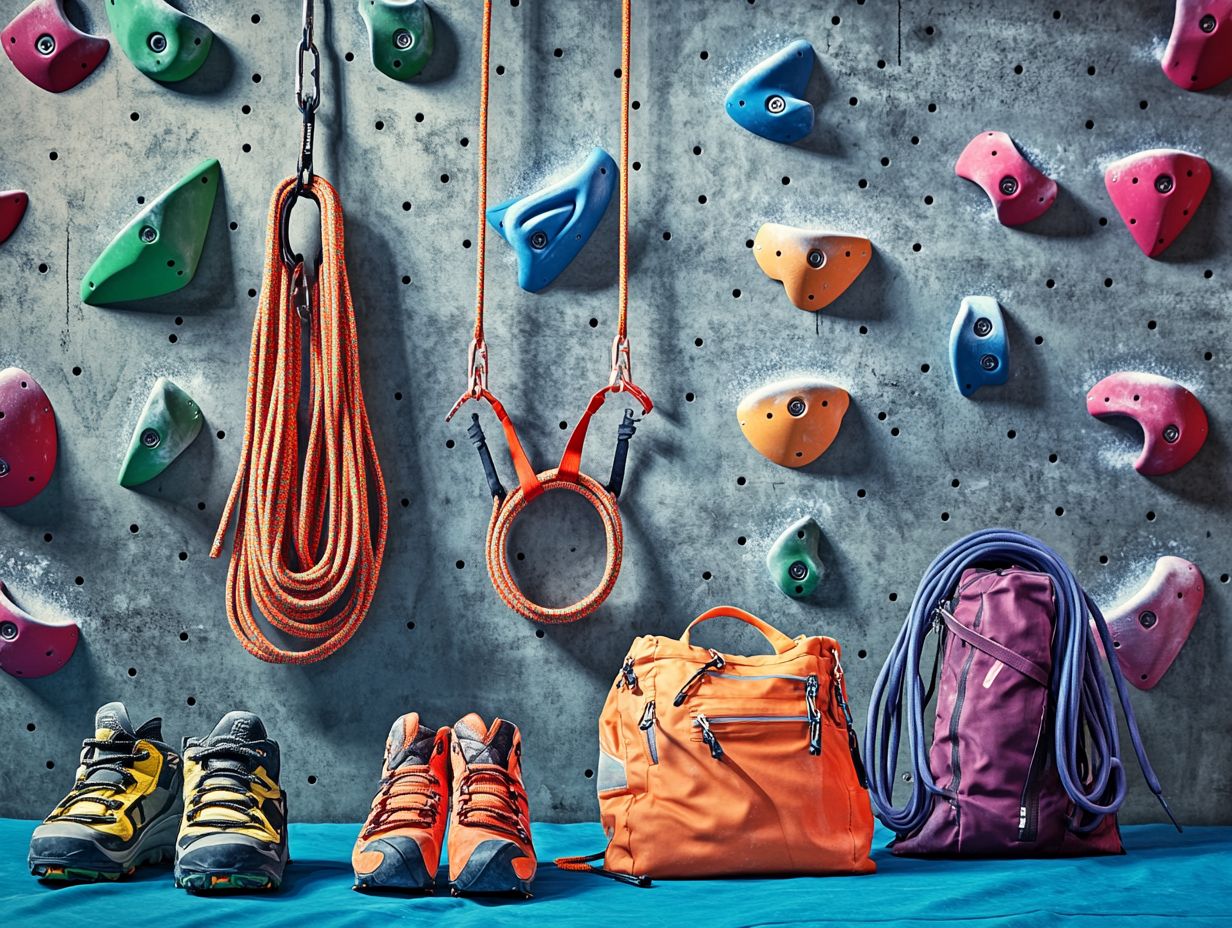
Indoor climbing etiquette is vital for a safe and enjoyable gym experience. Stay aware of your surroundings and wait your turn patiently while giving others enough space.
This not only builds a sense of friendship but also helps prevent accidents. Following safety rules, like using mats correctly and checking your harness, keeps everyone safe.
Embracing these guidelines helps create a supportive community that prioritizes respect, safety, and enjoyment for all participants.
Frequently Asked Questions
What is considered essential gear for indoor climbing?
Gear up for an adventure with these must-haves for indoor climbing! The essential gear typically includes climbing shoes, a harness, a chalk bag, a belay device, and a rope. These items are necessary for safety and comfort while climbing indoors.
Do I need to buy my own gear for indoor climbing?
It is recommended to have your own gear, especially if you plan on climbing frequently. However, most indoor climbing facilities offer rental gear for those who are just starting out or do not have their own gear.
What type of climbing shoes are best for indoor climbing?
Climbing shoes come in different styles. For indoor climbing, choose a comfortable pair with a good grip on the soles. Look for a snug fit without being too tight.
Can I use a regular gym bag for my climbing gear?
While you can technically use any bag to store your climbing gear, it’s recommended to use a specialized climbing backpack or duffel bag. These bags have specific compartments and features designed for carrying climbing gear.
Is it necessary to use a chalk bag while climbing indoors?
Using a chalk bag is not mandatory for indoor climbing, but it can help keep your hands dry and improve your grip on the holds. Many climbers find it helpful to use a chalk bag regardless of the type of climbing they are doing.
Do I need to bring my own rope for indoor climbing?
No, most indoor climbing facilities provide ropes for use. However, if you plan on purchasing your own gear, investing in a high-quality rope is recommended for safety and durability.

